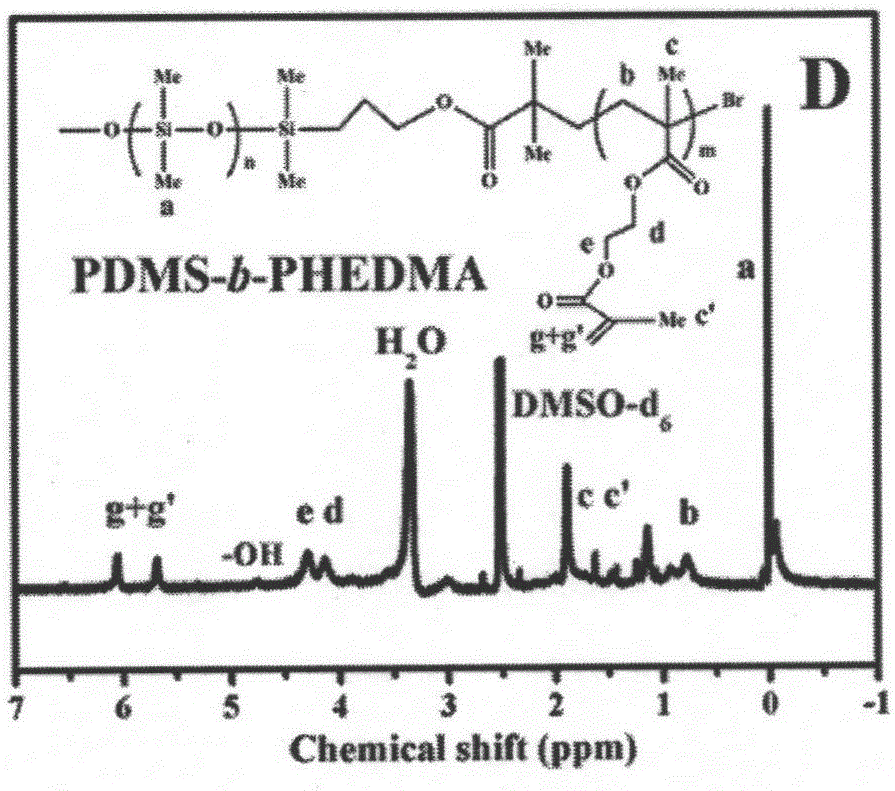Photocatalysis self-cleaned amphiphilic network ocean anti-flouring coating and preparation method thereof
A marine antifouling and self-cleaning technology, applied in antifouling/underwater coatings, coatings, biocide-containing paints, etc.
- Summary
- Abstract
- Description
- Claims
- Application Information
AI Technical Summary
Problems solved by technology
Method used
Image
Examples
Embodiment 1
[0086] A method for preparing a photocatalytic self-cleaning amphiphilic network marine antifouling coating, the specific steps are:
[0087] 1. Preparation of amphiphilic tri-block copolymers by ATRP (atom transfer radical polymerization) method:
[0088] (1) Preparation of PDMS-based macromolecular initiator:
[0089] Dissolve 10 parts of polydimethylsiloxane (here hydroxypolydimethylsiloxane) (company Gelest, type DMS-C21) (Mn=4000g / mol) in 80 parts of tetrahydrofuran to obtain functionalized Polydimethylsiloxane solution, add 0.5 parts of triethylamine, slowly drop 0.5 parts of 2-bromoisobutyryl bromide, react in an ice-water bath at -10°C for 3 hours, remove the precipitate by suction filtration after the reaction, The solvent was removed by rotary evaporation, then dissolved in n-hexane, washed and purified with deionized water three times, and dried in an oven for 24 hours to obtain a bromine-terminated PDMS-based macroinitiator.
[0090] (2) Preparation of PDMS-based...
Embodiment 2
[0104] Similar to Example 1, the difference is:
[0105] The preparation of step 6, photocatalytic self-cleaning amphiphilic network marine antifouling coating is as follows:
[0106] The obtained MPTS modified nano-titanium dioxide hybrid amphiphilic copolymer network coating is placed in a toluene solution of 0.1% trimesoyl chloride to react for 10 minutes, and after the reaction, the coating is taken out and placed in a concentration of 0.8%. Lysine-TiO 2 React in the dispersion liquid (the solvent is toluene) for 20 minutes, take it out, and obtain the photocatalytic self-cleaning amphiphilic network marine antifouling coating.
[0107] The original contact angle of the prepared marine antifouling coating is 100°, and the contact angle is reduced to 35° after 7 days of sunlight exposure, the breaking strength is 4.5MPa, the swelling rate in water is 2.5%, and the BSA adsorption capacity is 40ug / cm 2 , compared to glass sheets, can be reduced by 80%, and the adhesion of d...
Embodiment 3
[0109] Similar to Example 1, the difference is:
[0110] The preparation of step 6, photocatalytic self-cleaning amphiphilic network marine antifouling coating is as follows:
[0111] The obtained MPTS modified nano-titanium dioxide hybrid amphiphilic copolymer network coating is placed in a toluene solution of 0.3% trimesoyl chloride to react for 10 minutes, and after the reaction, the coating is taken out and placed in a concentration of 0.2%. Lysine-TiO 2 React in the dispersion liquid (the solvent is toluene) for 20 minutes, take it out, and obtain the photocatalytic self-cleaning amphiphilic network marine antifouling coating. The original contact angle of the prepared marine antifouling coating was 105°, and the contact angle decreased to 38° after 7 days of sunlight exposure, the breaking strength was 4.8MPa, the swelling rate in water was 2.3%, and the BSA adsorption capacity was 43ug / cm 2 , compared with the glass sheet, it can be reduced by 76%, and the adhesion am...
PUM
| Property | Measurement | Unit |
|---|---|---|
| Breaking strength | aaaaa | aaaaa |
| Adhesion amount | aaaaa | aaaaa |
| Breaking strength | aaaaa | aaaaa |
Abstract
Description
Claims
Application Information
 Login to View More
Login to View More - R&D
- Intellectual Property
- Life Sciences
- Materials
- Tech Scout
- Unparalleled Data Quality
- Higher Quality Content
- 60% Fewer Hallucinations
Browse by: Latest US Patents, China's latest patents, Technical Efficacy Thesaurus, Application Domain, Technology Topic, Popular Technical Reports.
© 2025 PatSnap. All rights reserved.Legal|Privacy policy|Modern Slavery Act Transparency Statement|Sitemap|About US| Contact US: help@patsnap.com



